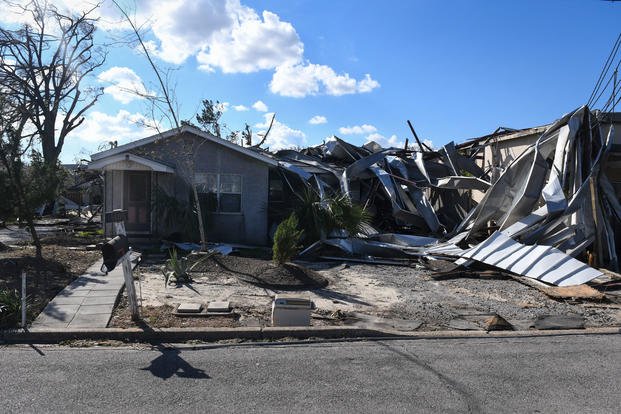Many of the 11,000 airmen and family members at Tyndall Air Force Base in the Florida Panhandle will face a permanent change of station (PCS) during the years it is expected to take the base to recover from the "catastrophic damage" of Hurricane Michael, Air Force officials said Tuesday.
The officials also continued to decline to state how many F-22 Raptors left at Tyndall during the storm were damaged. However, Brig. Gen. Ed Thomas, an Air Force spokesman, said, "We expect they'll all be fixable, they'll all be flyable. They generally look to be in good shape."
The same cannot be said for base housing. Thomas said all 867 homes sustained damage, most of them with roofs torn off.
Related: How you can help Tyndall families
"It's fair to say it will be years to make Tyndall look like what it did before the hurricane hit," Brig. Gen. John Allen, director of civil engineering for the Air Force, said in a briefing with defense reporters at the Pentagon.
He added, "I would be surprised if you saw a large construction effort at temporary housing" to bring back displaced families.
Beginning Wednesday, and continuing through Oct. 21, Tyndall families who evacuated before Hurricane Michael came ashore as a Category 4 storm will be allowed back onto the base to survey the damage to their homes and take away valuables, the officials said.
The families can go back to their housing between the hours of 10 a.m. and 3 p.m., but will not be allowed to remain, for safety reasons, Thomas said.
"We understand this process will be long," Maj. Gen. Andrew Toth, commander of the Air Force Personnel Center, said of the efforts to repair the base and resettle families.
The service is attempting to come up with solutions for the problems faced by Tyndall families, "whether it's financial or trying to get the kids back in school," he added.
Many of the families were evacuated to Hurlburt Field and Eglin Air Force Base in Florida, and to Randolph Air Force Base in Texas, Toth said.
"We want to see what their long-term options are. It's important we get it right," he said.
As for how many will need to PCS, "we're working through all that right now. None of that has been completely determined yet," he said.
The Air Force has been particularly tight-lipped on the number of F-22s that had remained on base and were damaged in the storm. Some of the 5th-generation Raptors were undergoing repairs and could not be flown out before the storm hit.
Allen said that five to seven temporary hangars are being constructed at Tyndall, each capable of housing two aircraft, but he cautioned against assuming that 10 to 14 Raptors may have been damaged. Allen and Thomas said that other aircraft, including F-15 Eagles, were also on the base when the storm hit.
The hurricane severely damaged the hangars of the F-22s, Thomas said, adding that the first step is to bring in equipment to clear debris to enable the aircraft to be towed to the temporary hangars.
The officials likened the recovery effort at Tyndall to the one that took place at Keesler Air Force Base in Biloxi, Mississippi, which was heavily damaged when Hurricane Katrina hit the Gulf Coast in 2005. The recovery effort at Keesler took nearly five years, the officials said.
-- Richard Sisk can be reached at Richard.Sisk@Military.com.













